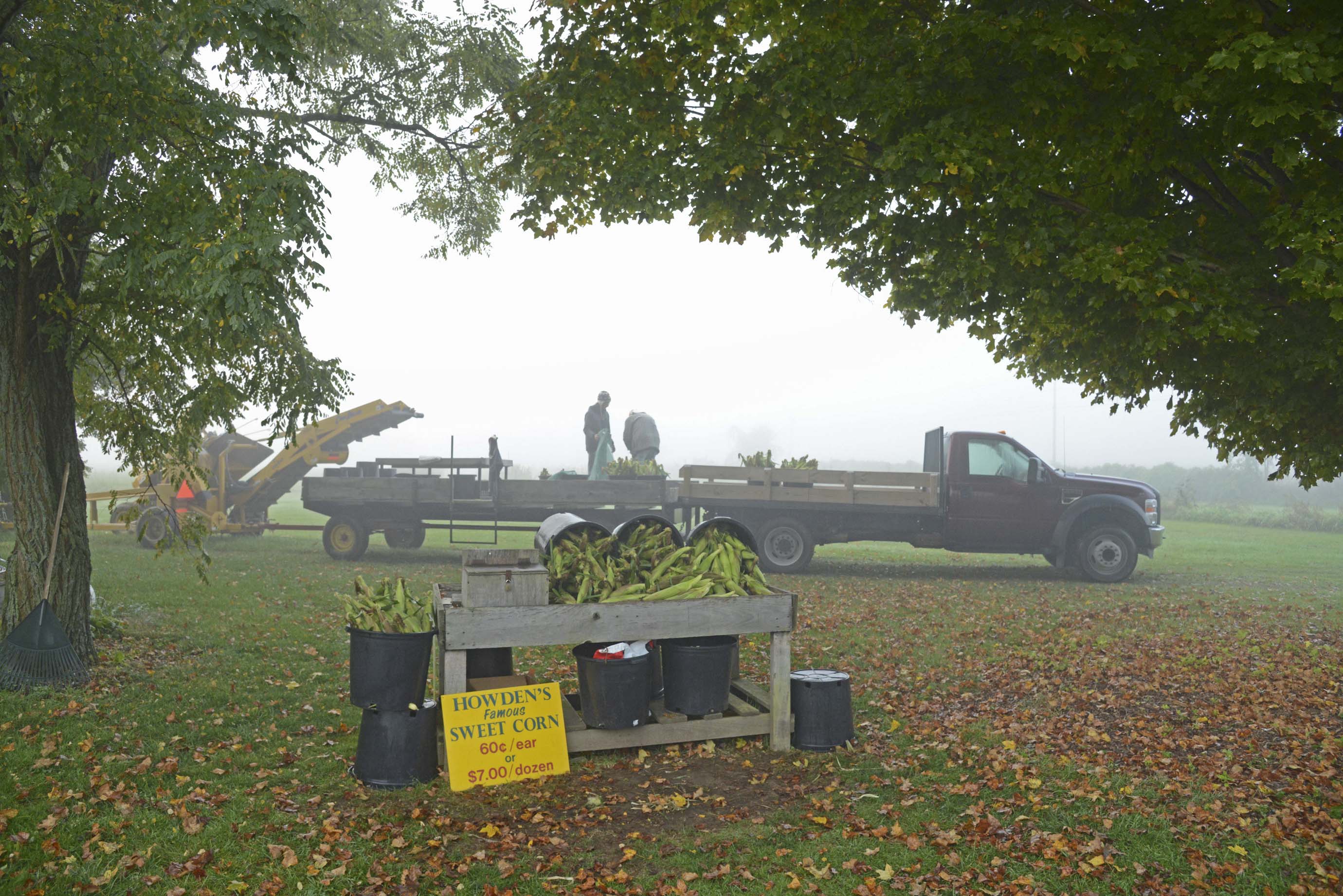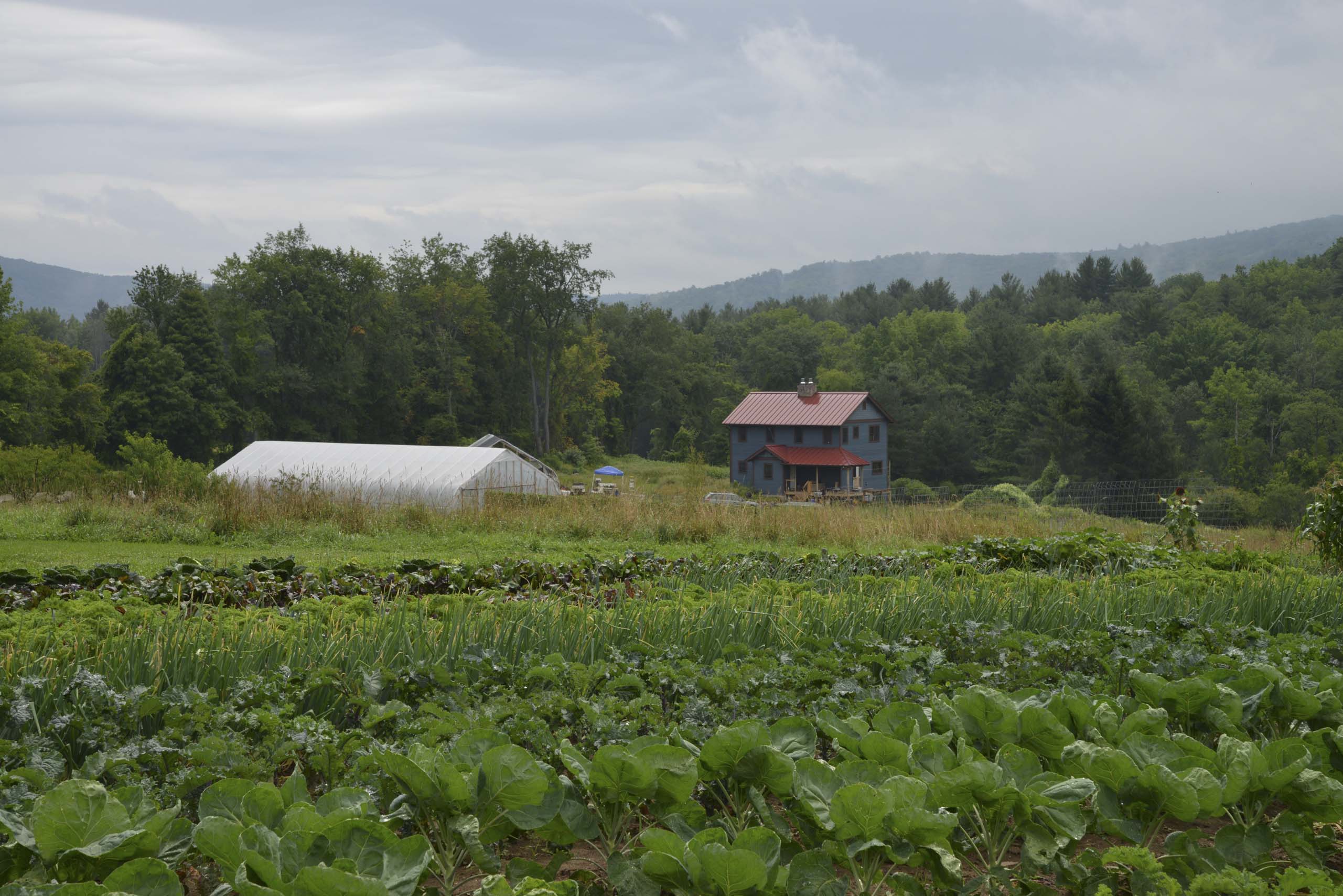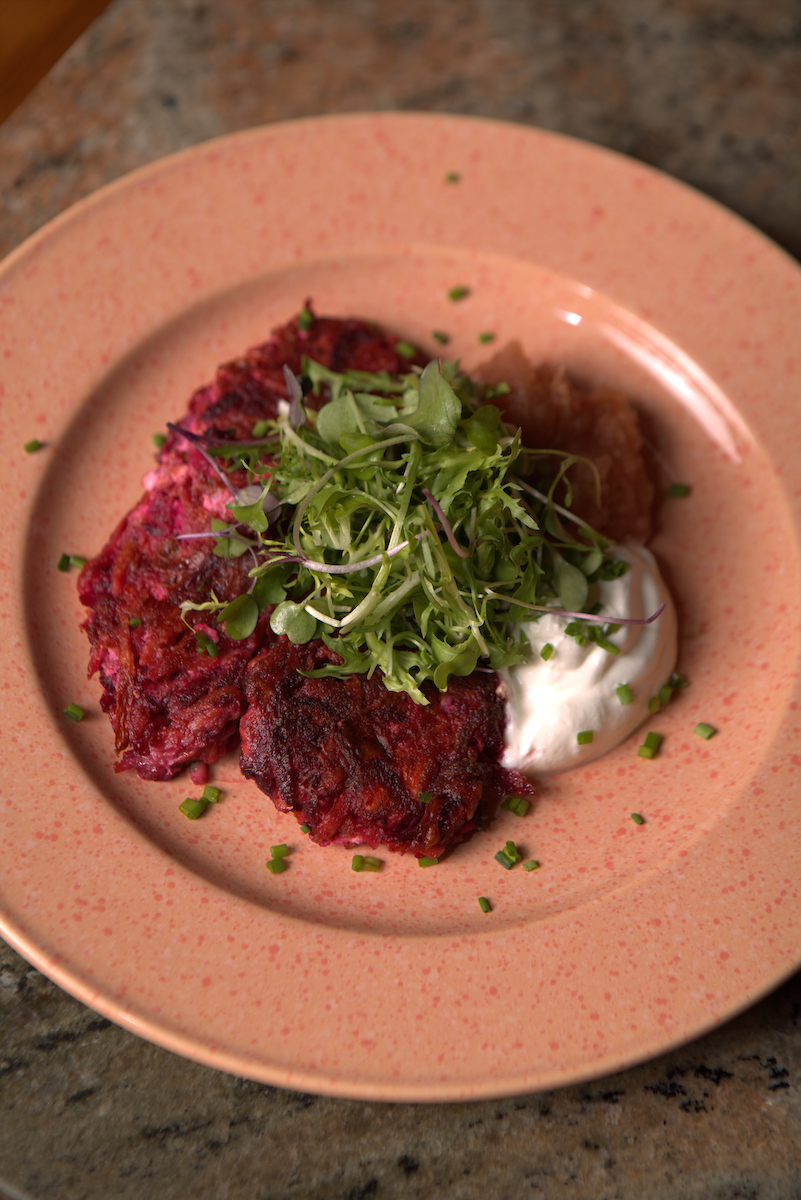
©Robert Bildner
I’m the author, with my husband, Rob Bildner, of the Berkshires Farm Table Cookbook, and I know you’re going to ask me, what’s Jewish about a cookbook with a name like that? It’s an understandable question, and bear with me for a moment for a slightly long answer.
In grade school, Rafi, the youngest of our four children, started gardening in our backyard in Becket, MA, in the Berkshire Hills;it’s a magical area in New England, infused with natural beauty and cultural institutions galore, where we’ve been part-time residents for thirty-five years. Rafi began by selling his produce at a roadside stand during his middle school years, and moved on to attending The Mountain School in rural Vermont during his junior year, which teaches high school students how to farm.
For the following two summers, he transformed his childhood garden into October Mountain Farm, an intensively cultivated sustainable half acre of lettuce, tomatoes, and more exotic vegetables; this time he sold them mostly at local farmers’ markets.
We visited Rafi at these markets, marveling at his Red Russian Kale and rhubarb, but keenly aware of the long hours and grueling work it took to get those products to his customers. We were also aware of how little money he made, especially considering he didn’t have to rent or buy land. While we celebrated Shabbat, he invariably worked almost through the night to wash, process and bag his produce to get ready to sell at the Saturday farmers market.
At these markets, we met local farmers and were moved by their stories of how they came to farm; we admired their commitment to the soil, the environment and to producing clean, healthy food that tastes great. As one farmer, Amelia Conklin of Sky View Farm in Sheffield, MA, told us, “Anybody that has eaten a carrot that’s fresh and local and grown organically or sustainably, versus a carrot that’s traveled 1200 miles or more, knows the taste is just so, so different.”
We thought a cookbook based on what is grown in the Berkshires — an area that encompasses western Massachusetts and parts of New York, Vermont, and Connecticut — would offer a way to support local farmers.
While both Rob and I trained as lawyers, most of our professional career has been in the food business. Rob is the third generation in his family to do so — he founded and ran two food companies that distributed fresh produce and specialty foods, and helped farmers bring their products to market. After he sold the business he studied photography. I am a former journalist and a journalism professor, with chef’s training and a master’s degree in nutrition, and I had experience running another one of our companies. So I grabbed my laptop and Rob packed up his digital recorder and camera, and we traipsed down relatively untraveled dirt roads over five years to interview farmers.
The main goal behind creating our cookbook, of course, is to help readers create great food — check out the recipe for beet and goat cheese latkes at the end of this piece — but its other objective is to offer compelling reasons why you should buy and eat locally, and to introduce you to the folks behind these fresh ingredients. The book features 125 recipes inspired by these farmers, as well as some adapted from local farm to table chefs, along with forty-two profiles of the memorable people we met on our journey.
I grabbed my laptop and Rob packed up his digital recorder and camera, and we traipsed down relatively untraveled dirt roads over five years to interview farmers.

©Robert Bildner
But now for the Jewish part: Rob and I are convinced that buying local is a quintessentially Jewish act. We argue that the farmers we profiled operate their small family farms in ways that parallel Jewish precepts concerning agriculture and food — whether these individuals are Jewish or not (two that we interviewed are). We think it’s worth changing our food buying habits to help us incorporate into our lives Jewish values such as bal tashchit, which prohibits waste or destroying resources; tzaar baalei chayim, not letting animals suffer; and oshek, not oppressing workers. Before I go further, I strongly suggest a book essential to my learning, The Sacred Table, Creating a Jewish Food Ethic, edited by Mary L. Zamore.
The principle of bal tashchit is based foremost in Deuteronomy, and is constantly invoked by Jewish environmentalists to illustrate the idea that we must treat our planet with care: “When in your war against a city you have to besiege it a long time in order to capture it, you must not destroy its trees, wielding the ax against them. You may eat of them, but you may not cut them down.” So even in war, we must treat the environment with respect. Similarly, in Genesis, Adam and Eve were anointed “shomrei adamah, guardians of the earth.” The farmers we interviewed use sustainable practices; for example, they lightly till the soil, helping to keep carbon out of the atmosphere.
Batsheva Appel in The Sacred Table offers additional support for the idea that being a locavore is a Jewish value. According to Rabbi Yosei in the Jerusalem Talmud, “It is forbidden to live in a town that has no garden or greenery.” Essentially Appel insists that we must not live in a place without a source of fresh produce. When we buy local, we’re helping small family farms succeed, and we continue to preserve these green spaces and stop harmful developments. But the ramifications go beyond an individual locality: the availability of locally grown food reduces dependence on food that’s been shlepped cross country — our norm — adding to environmental destruction and violating bal tashchit.
The principle of tza’ar baalei chayim amounts to not letting animals suffer. God gives humans dominion over animals in Genesis, but it’s tempered by many other Torah passages that demand we prevent their suffering. Tza’ar baalei chayim is said to derive from Exodus: “When you see the ass of your enemy lying under its burden and would refrain from raising it, you must nevertheless help raise it.” One pork farmer we interviewed, Schuyler Gail, echoed other meat farmers concerned about the welfare of their animals, saying, “We’re taking lives for our consumption and that’s not something to be taken lightly.” She notes in her blog that people always ask whether it disturbs her and her husband to slaughter. “It’s sad every time,” she writes. She goes on to explain, “These are living things, some of whom are extremely cute and/or animals we have known since the moment they were born, and we choose to kill them. When killing animals we care about becomes nonchalant and fails to stir our emotions, then we will know we need to stop raising animals for meat. We respect our animals in life and we are thankful for them in death.”
Batsheva Appel in The Sacred Table offers additional support for the idea that being a locavore is a Jewish value.

©Robert Bildner
The principle of oshek urges us not to oppress workers. Leviticus commands us, “You shall not defraud your fellow. You shall not commit robbery. The wages of a laborer shall not remain with you until morning.”As Sean Stanton, a farmer in Great Barrington, MA, reminds us, workers in conventional large scale slaughterhouses toil for low wages in unacceptable conditions, just one example of worker oppression in commercial agriculture. Sean says his animals eat costly certified or transitional organic feed. Slaughtering them is expensive too; $400 for a pig at the small New England slaughterhouse he uses, compared to the $20 to $30 it costs large agricultural processors. But he says what consumers don’t know about are the hidden costs. Large producers slaughter 10,000 pigs a day, rather than the twenty or fewer at Sean’s facility, taking advantage of economies of scale. Those lower prices, though, also result from what he argues is the inhumane way the giant slaughterhouses structure the workday for those who do the killing. He goes on to say, “We talk about animal rights all the time. When you go to these places and see the kinds of jobs workers are doing for 8 to 10 hours a day, it’s as much a human rights issue as an animal welfare issue.”
I’ll stop here. After all, this is a cookbook! It’s really two books in one, an accessible cookbook that you’d want to take with you to the farmers’ market, and a journalistic treatise with stories and photos Rob took of small family farms.
I promised you a recipe, so let’s make it a Jewish one, Savory Beet Latkes, inspired by Hawk Dance Farm, Hillsdale, NY, and Rawson Brook Farm, Monterey, MA. And, of course, you can find many more through our website, berkshiresandbeyond.com. B’tai avon!
Savory Beet Latkes
Serves 6, makes about 18 pancakes
These beet pancakes are also great for using up a variety of other root vegetables. Using a food processor will make quick work of the shredding aspect of the preparation. With a nice browned crust, the latkes are delicious served with applesauce, for which we have a simple recipe, or sour cream and chives, and offer a good alternative to hash browns at breakfast or brunch.
¼ cup chopped scallions, white and green parts (about 2 large)
1 tablespoon chopped fresh thyme
1 teaspoon kosher salt, or more to taste
2 cups peeled and shredded red beets, peeled and shredded (about 11 ounces, 2 to 3 medium beets)
1 cup peeled and shredded carrots (about 6 ounces, 2 to 3 medium carrots)
1 cup peeled and shredded celery root (about 8 ounces, ½ small celery root)
1 cup peeled and shredded Idaho or russet potato (about 12 ounces, 1 large potato)
¼ cup rye or whole wheat flour, or more as needed to hold the raw latkes together
1 cup crumbled Rawson Brook Farm chevre, or other soft goat cheese (about 5 ounces)
1 large egg, lightly beaten
2 tablespoons neutral oil, such as canola, plus more as needed, for frying
¼ cup sour cream, per person, for serving (optional)
Sour cream and chopped chives, or applesauce for garnish (optional)

©Clay Williams Photography
1. Prepare a plate with layers of paper towels to drain the pancakes.
2. Place the scallions, thyme, salt, beets, carrots, celery root, and potatoes in a large bowl and mix well. Use a paper towel to gently squeeze out any excess moisture. Scatter the flour on top of the shredded vegetables and mix until well incorporated.
3. Combine the cheese and egg in a small bowl. Fold into the vegetable mixture until well-coated.
4. Heat the oil in a heavy-bottomed skillet over medium heat until shimmering. Working in batches, so as not to crowd the pancakes, use a ¼‑cup measure to scoop the vegetable mixture into the skillet. Flatten the mixture gently, using the back of the measuring cup or a spatula, making sure the pancakes do not touch each other. Fry for 4 to 5 minutes on one side, until browned and crisp, and then flip to fry the other side for the same amount of time, or until browned and crisp. Transfer the latkes to the l ined plate to drain. Repeat until the entire vegetable mixture has been used. If more oil is needed for frying subsequent batches, add as necessary.
5. Serve the beet latkes warm with sour cream and chives or with applesauce as a garnish.
This essay is adapted from a talk the author gave at the JCC of Manhattan.
Elisa Spungen Bildner is a former lawyer, CEO of a food company newspaper, editor/reporter (Star Ledger, Newark, NJ) and journalism professor (Rutgers University and New York University). Spungen Bildner is also a professionally trained chef (School of Natural Cookery, Boulder, CO) and yoga instructor. She graduated from Yale College, Columbia University Law School, and also has an MS in Nutrition.